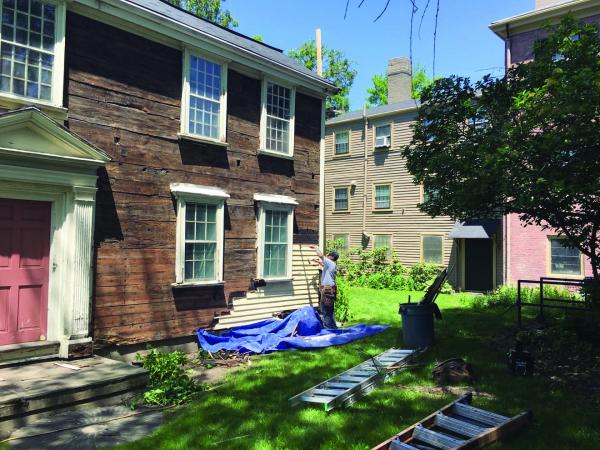May 31, 2018

Restoration work on the exterior of the Lemuel Clap House on Boston Street is ongoing this season. Peggy Mullen photo/DHS
Over its 175 years of existence, the Dorchester Historical Society has collected, preserved, and shared knowledge about what happened in the old Puritan town since it was established in 1630.
While actively maintaining several classic properties, accumulating artifacts of importance, and offering programming from its Boston Street base, the society is also adapting to modern pressures as it charts its way into the future.
The society oversees and maintains several of Dorchester’s classic homes, like the Clapp houses on Boston Street. The William Clapp house, newly spruced up and with a fresh coat of historically accurate paint, is where the group gathers for monthly meetings.
“We’re finally at the finish of our long-term plan to restore the exterior of all our properties,” said Earl Taylor, the society’s president. Forthe past 15 years, the society has been all about restoring the James Blake house, The Clapp family barn and carriage house, and the William Clapp and Lemuel Clap houses. The Lemuel Clap, which is currently being renovated, has exterior siding that is “in bad shape,” Taylor said. “It’s been neglected for a long time.”
As they did with work on the William Clapp house, the historical society and its consultant conferred on the appropriate outside color scheme for Lemuel’s old home, which will be roughly the reverse of the neighboring house.
Their ability to do the rehabbing work is “a testament to the charitableness of Dorchester stakeholders,” Taylor said. The society has also applied for a Community Preservation Act grant to do the final exterior work, including painting the barn and repairing the fencing, said board member Vicki Rugo.
Funds donated to the society are used for ongoing preservations efforts, programs, and the never-ending parade of cataloguing historic documents and artifacts. They are about 300 years behind on cataloguing, Taylor jokes, but “I’m always pleased when we get a new piece of Gleason pewter.”
Dorchester tinsmith Roswell Gleason and one of his sons opened the first silver-plating establishment in America on Washington Street in the early- to mid-1800s. His work evolved from simple and traditional styles to a more heavily ornamented and opulent look to better suit his Victorian clientele. Pieces of his work crop up every once in a while, Taylor said, and the historical society moves to add them to its collection.
On the third Sunday of each month, the group gathers in the Clapp house for presentations like the one Jim Vrabel and Lew Finfer gave on activism in Dorchester in the 1960s and 1970s. The society also hosts tours of the neighborhood houses and walking tours on a regular basis.
“We’ve always had programming going, but we want to spend more time dealing directly with programming to see if we can get more diversity in our programs,” Taylor said. “We’ve long neglected the 20th century.”
Rugo and Taylor are acutely aware of the need to expand the society’s board and membership, including bringing in younger and more representative participants.
“We’re looking to diversify our membership; broaden it, get the younger people involved,” Rugo said. “So I think our focus after the properties — and there was so much deferred maintenance over the years that predates when Earl and all the other people were involved with the Boston Street properties and the Blake House – should be on programming and finding ways to broaden our appeal.”
The society’s online presence has expanded in recent months. There’s more activity on its Twitter handle @DotHist and on Facebook with mystery photos and archived images, and there are neighborhood trivia nights at the nearby Dorchester Brewing Company.
Although the recently revived gem of a fundraising effort, the Dorchester House Tour, is not taking place this year, the group is hopeful that they will be able to expand out into villages beyond the Ashmont area for next year.
New board members are bringing different parts of Dorchester into the mix, Rugo said, which is an encouraging shift. “Everybody’s history is important,” Rugo said. “It’s not just that you were a Blake or a Clapp or came over on the Mary and John.”


